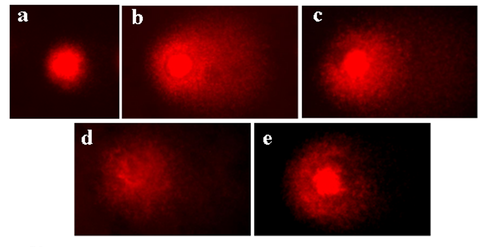Comet assays are used to determine the extent of DNA damage in a cell. This information can provide a great deal of useful information regarding the diagnosis and progression of diseases, the value of different therapies, and the environmental and occupational exposure to harmful chemicals.
In the process, an electrical current is applied to a slide featuring the cell in a gel. Any broken strands of DNA move away from their original location towards the positive charge leaving a comet trail made visible through fluorescence. The trail can give clues to much detail about the DNA which can help in various applications. Companies such as AMSBIO are also developing the system to further refine the technology.

DNA damage (tail intensity) detected by the Comet Assay, credit: Aviello et al. (2011) PLOS Journal
Comet assays applications
Chronic and degenerative diseases
DNA damage is a contributing factor for many diseases – the alkaline comet assay can determine the extent of this. Such damage can be found in long-term diseases such as diabetes mellitus (in which the body is unable to produce enough insulin) and rheumatoid arthritis (characterized by inflammation and pain in the joints).
Additionally, neurodegenerative diseases such as Alzheimer’s disease can cause DNA damage. Oxidative stress may be a likely cause of the DNA damage in these diseases. It can result when free radicals are formed from either essential internal metabolic processes or environmental sources including exposure to radiation (X-rays, ozone) or chemicals (smoking, air pollutants).
Cancer treatment (chemotherapy and radiotherapy)
In the absence of appropriate cellular regulation and repair, DNA damage and abnormalities can accumulate and lead to the development and progression of cancer. Scientists have studied the presentation and extent of DNA damage in different forms of cancer as a tool to help with diagnosis. The accumulated information has the potential to help doctors treat patients who are undergoing cancer treatment.

Comet assay techniques can also be used in the screening of compounds for use in cancer medication for patients. The process offers a way to determine the sensitivity of tumors to radiotherapy or chemotherapy treatments. An alkaline comet assay has already been employed in these tests to provide information about the sensitivity of tumors to doses of radiation. It has been found to be valuable in colon, prostate and breast cancers.
Assessing the extent of DNA cross-linking and alkylation in combination with DNA strand breakage can also be useful when determining the response of tumors to chemotherapeutic treatments. In fact, scientists have found that there is a clear dose-response and time-response for DNA double strand breaks which can be obtained via comet assay methods.
Evaluation of geno-toxicity
Genotoxic and non-genotoxic chemicals can be differentiated through comet assays. This can be helpful in identifying the genotoxic impact of chemicals and carcinogens. The comet assay can even be used as a biomarker to give some indication of genetic susceptibility in addition to detecting potentially carcinogenic DNA damage and assessing cell and tissue genotoxicity.
Biomonitoring of occupational and environmental exposure
A comet assay is useful to detect the level of exposure of populations to genotoxic chemicals and pollutants present in the environment such as those used in manufacturing processes. The assay can therefore be used to determine the impact of these on the health of people living or working near them. Areas which have been studied include crude oil refineries, factories producing certain chemicals and waste refineries.

The DNA damage occurs in the peripheral blood lymphocyte cells (PBL) due to their exposure to metals, chronic and low doses of radiation, volatile organic compounds and antineoplastic drugs. The resultant DNA damage shows a correlation with micronucleus assay results and chromosomal defects.
A comet assay is used here due to the higher sensitivity, speed and reproducibility offered in comparison to other assays which could be used to study the DNA damage instead.
References:
- Nature Protocols on The comet assay: a method to measure DNA damage in individual cells: http://www.nature.com/nprot/journal/v1/n1/full/nprot.2006.5.html
- Journal of Clinical & Diagnostic Research on comet assay applications: http://www.ncbi.nlm.nih.gov/pmc/articles/PMC4413081/
- http://www.ncbi.nlm.nih.gov/pmc/articles/PMC3249911/
Further Reading